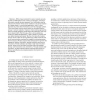Free Online Productivity Tools
i2Speak
i2Symbol
i2OCR
iTex2Img
iWeb2Print
iWeb2Shot
i2Type
iPdf2Split
iPdf2Merge
i2Bopomofo
i2Arabic
i2Style
i2Image
i2PDF
iLatex2Rtf
Sci2ools
TMC
2012
2012
Protecting Location Privacy in Sensor Networks against a Global Eavesdropper
— While many protocols for sensor network security provide confidentiality for the content of messages, contextual information usually remains exposed. Such information can be critical to the mission of the sensor network, such as the location of a target object in a monitoring application, and it is often important to protect this information as well as message content. There have been several recent studies on providing location privacy in sensor networks. However, these existing approaches assume a weak adversary model where the adversary sees only local network traffic. We first argue that a strong adversary model, the global eavesdropper, is often realistic in practice and can defeat existing techniques. We then formalize the location privacy issues under this strong adversary model and show how much communication overhead is needed for achieving a given level of privacy. We also propose two techniques that prevent the leakage of location information: periodic collection and ...
Classic Security Services | Logical Reasoning | Target Object | TMC 2012 | Wireless Sensor Network |
| Added | 29 Sep 2012 |
| Updated | 29 Sep 2012 |
| Type | Journal |
| Year | 2012 |
| Where | TMC |
| Authors | Kiran Mehta, Donggang Liu, Matthew Wright |
Comments (0)

